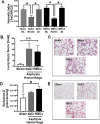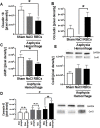Lung injury after asphyxia and hemorrhagic shock in newborn piglets: Analysis of structural and inflammatory changes
- PMID: 31276543
- PMCID: PMC6611609
- DOI: 10.1371/journal.pone.0219211
Lung injury after asphyxia and hemorrhagic shock in newborn piglets: Analysis of structural and inflammatory changes
Abstract
Objective: Asphyxia of newborns is a severe and frequent challenge of the peri- and postnatal period. The purpose of this study was to study early morphological, immunological and structural alterations in lung tissue after asphyxia and hemorrhage (AH).
Methods: 44 neonatal piglets (age 32 hrs) underwent asphyxia and hemorrhage (AH) and were treated according to the international liaison committee of resuscitation (ILCOR) guidelines. For this study, 15 piglets (blood transfusion (RBC) n = 9; NaCl n = 6, mean age 31 hrs) were randomly picked. 4 hours after ROSC (return of spontaneous circulation), lung tissue and blood samples were collected.
Results: An elevation of myeloperoxidase (MPO) activity was observed 4 hrs after AH accompanied by an increase of surfactant D after RBC treatment. After AH tight junction proteins Claudin 18 and junctional adhesion molecule 1 (JAM1) were down-regulated, whereas Occludin was increased. Furthermore, after AH and RBC treatment dephosphorylated active form of Connexin 43 was increased.
Conclusions: AH in neonatal pigs is associated with early lung injury, inflammation and alterations of tight junctions (Claudin, Occludin, JAM-1) and gap junctions (Connexin 43) in lung tissue, which contributes to the development of lung edema and impaired function.
Conflict of interest statement
The authors have declared that no competing interests exist.
Figures




Similar articles
-
Tissue damage in the heart after cardiac arrest induced by asphyxia and hemorrhage in newborn pigs.Pediatr Res. 2019 Dec;86(6):709-718. doi: 10.1038/s41390-019-0505-6. Epub 2019 Jul 23. Pediatr Res. 2019. PMID: 31336381
-
Junctional adhesion molecule A promotes epithelial tight junction assembly to augment lung barrier function.Am J Pathol. 2015 Feb;185(2):372-86. doi: 10.1016/j.ajpath.2014.10.010. Epub 2014 Nov 28. Am J Pathol. 2015. PMID: 25438062 Free PMC article.
-
Comparison of Different Compression to Ventilation Ratios (2: 1, 3: 1, and 4: 1) during Cardiopulmonary Resuscitation in a Porcine Model of Neonatal Asphyxia.Neonatology. 2018;114(1):37-45. doi: 10.1159/000487988. Epub 2018 Apr 12. Neonatology. 2018. PMID: 29649792
-
Transmembrane proteins of tight junctions.Semin Cell Dev Biol. 2000 Aug;11(4):281-9. doi: 10.1006/scdb.2000.0177. Semin Cell Dev Biol. 2000. PMID: 10966862 Review.
-
The roles of claudin superfamily proteins in paracellular transport.Traffic. 2001 Feb;2(2):93-8. doi: 10.1034/j.1600-0854.2001.020203.x. Traffic. 2001. PMID: 11247307 Review.
Cited by
-
[A review on the effect of Claudin-18 on bronchopulmonary dysplasia in preterm infants].Zhongguo Dang Dai Er Ke Za Zhi. 2021 May;23(5):542-547. doi: 10.7499/j.issn.1008-8830.2101025. Zhongguo Dang Dai Er Ke Za Zhi. 2021. PMID: 34020748 Free PMC article. Review. Chinese.
-
Tight Junctions, the Epithelial Barrier, and Toll-like Receptor-4 During Lung Injury.Inflammation. 2022 Dec;45(6):2142-2162. doi: 10.1007/s10753-022-01708-y. Epub 2022 Jul 2. Inflammation. 2022. PMID: 35779195 Free PMC article. Review.
-
Expiratory braking defines the breathing patterns of asphyxiated neonates during therapeutic hypothermia.Front Pediatr. 2024 May 20;12:1383689. doi: 10.3389/fped.2024.1383689. eCollection 2024. Front Pediatr. 2024. PMID: 38832000 Free PMC article.
-
Effect of miR-21-3p on lung injury in rats with traumatic hemorrhagic shock resuscitated with sodium bicarbonate Ringer's solution.Ann Transl Med. 2022 Dec;10(24):1331. doi: 10.21037/atm-22-5148. Ann Transl Med. 2022. PMID: 36660723 Free PMC article.
-
Claudin-18 expression under hyperoxia in neonatal lungs of bronchopulmonary dysplasia model rats.Front Pediatr. 2022 Oct 10;10:916716. doi: 10.3389/fped.2022.916716. eCollection 2022. Front Pediatr. 2022. PMID: 36299696 Free PMC article.
References
-
- Gillam-Krakauer M, Gowen Jr CW. Birth Asphyxia. StatPearls. Treasure Island (FL); 2017. - PubMed
-
- Correale M, Nunno L, Ieva R, Rinaldi M, Maffei G, Magaldi R, et al. Troponin in newborns and pediatric patients. Cardiovasc Hematol Agents Med Chem. 2009; 7: 270–278. - PubMed
-
- Martin-Ancel A, Garcia-Alix A, Gaya F, Cabanas F, Burgueros M, Quero J. Multiple organ involvement in perinatal asphyxia. J Pediatr. 1995; 127: 786–793. - PubMed
Publication types
MeSH terms
Substances
LinkOut - more resources
Full Text Sources
Research Materials
Miscellaneous

